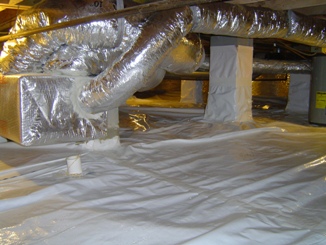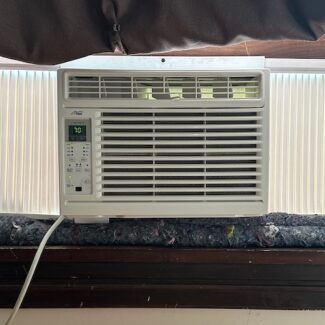As detailed in the first article in this series on crawl space encapsulation and in this blog article, vented crawl spaces have a number of problems that seriously degrade a home’s performance. The best alternative is to encapsulate the crawl space, or else design it away altogether if you’re building new.

The photo above shows what an encapsulated crawl space looks like. Although any color vapor barrier will work, using white makes the crawl space bright and cheery. (So cheery, in fact, that you might need to lock it to keep the kids from turning it into a playroom.)
Here are the basic features of an encapsulated crawl space:
- 100% coverage of the ground with a vapor barrier
- Seams and junctions of vapor barrier sealed
- Sealed crawl space vents
- Insulated foundation walls and band joist (usually)
- Conditioning of air with one of three methods: (i) dehumidifier, (ii) small amount of supply air from HVAC system, or (iii) small exhaust fan
The benefits of this treatment are significant. As shown in the first article of this series, the relative humidity will stay below 60%, even when the outdoor humidity is much higher. With dehumidification, it’s not difficult to reduce the humidity to less than 50%.
Some other benefits are:
- Better air quality in the crawl space, which means better air quality in the living space
- Greater energy efficiency. The Advanced Energy studies have found nearly 20% reduction in energy use in homes with a conditioned crawl space.
- Fewer critter problems
- Greater durability of floor, HVAC equipment, and other components in the crawl space
- Greater comfort in the home because of reduced humidity and crawl space temperatures close to living space temperatures
There are also, of course, some caveats that come with this method of treating crawl spaces. For one, a crawl space with atmospheric combustion appliances should not be encapsulated. Second, all bulk water problems need to be fixed before encapsulating. And third, building officials and pest control companies have to be on board to prevent problems down the road.
Is It Bad When the Air Conditioner Runs A Lot?
I can't tell you how many times I've heard someone complain that their air conditioner runs all the time. Now,…
I want to learn from the best and I’m very happy I made the trip to Atlanta to train with Energy Vanguard.

